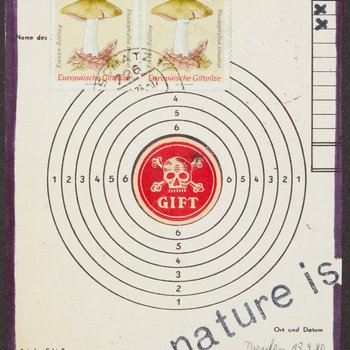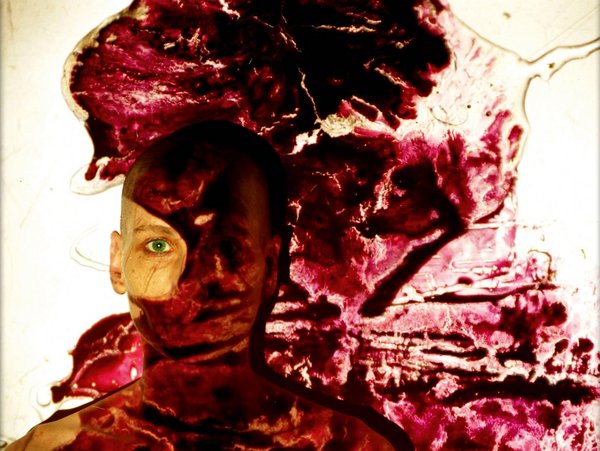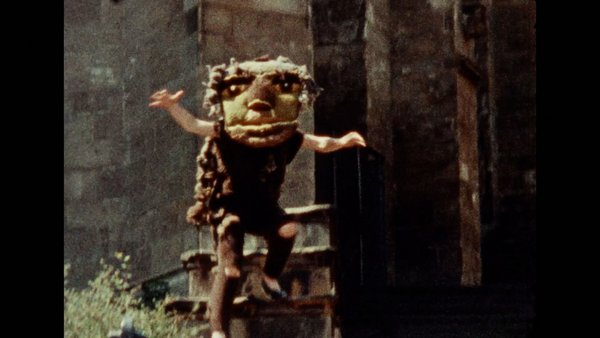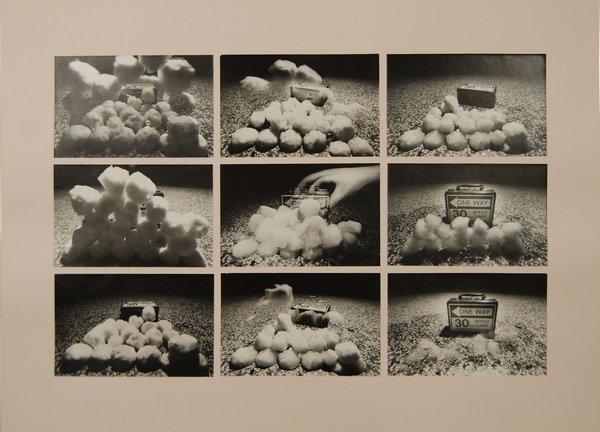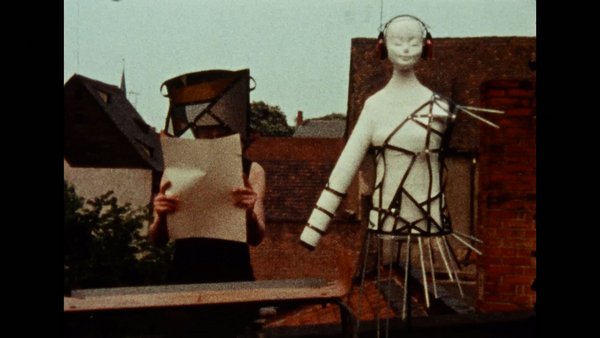Voices of Women Action Artists from the GDR
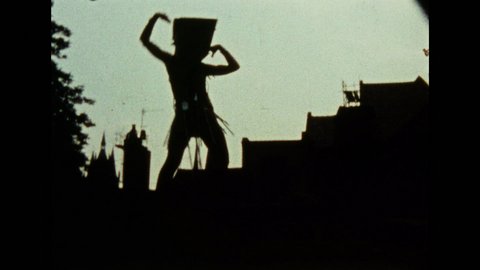
Verena Kyselka’s costume "The News Reader" (1989) in the Super 8 film "Signals" (1989) by the Erfurt Women Artists’ Group, private archive of Gabriele Stötzer
© Verena Kyselka; Gabriele Stötzer; VG Bild-Kunst, Bonn 2025
Performance art lives in the blink of an eye. It happens in the moment, directly with the body and thereby resists traditional collection and exhibition practices at the museum. In the GDR, this art form was a means of creating free spaces and questioning artistic conventions.
The exhibition Stepping Out of Line. Women Action Artists in the GDR, curated by Linda Alpermann, Sarah Felix, Jan-Markus Göttsch and Ramona Stauner, was dedicated exclusively to women artists from the Erfurt and Dresden scenes. Photographs, films, costumes and other relics were shown – fragments that tell of fleeting actions and give insights into artistic practices that were never meant for the museum.
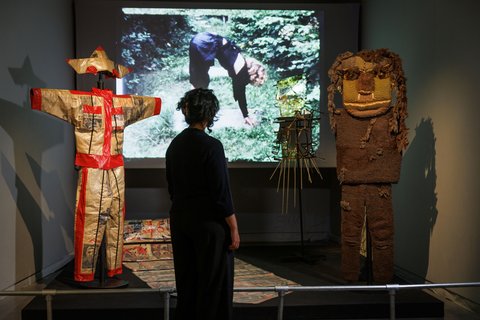
Curator Sarah Felix at the exhibition "Stepping Out of Line" at the Albertinum 2025
© Staatliche Kunstsammlungen Dresden, Albertinum, Photo: Oliver Killig; VG Bild-Kunst, Bonn 2025
In order to continue amplifying the voices of the exhibited artists beyond the exhibition period, we conducted video interviews with the participants. The protagonists give an account of their artistic self-understanding, their strategies in the field of tension between control and subculture, and of the resonance of their works up to today.
![[Translate to English:] KilligBild [Translate to English:] ddr kunst museum skd](/fileadmin/_processed_/7/e/csm_150525killig017_70b815e458.jpeg)
Interview with Gabriele Stötzer, Monika Andres and Verena Kyselka at the exhibition "Stepping Out of Line" at the Albertinum
© Staatliche Kunstsammlungen Dresden, Albertinum, Photo: Oliver Killig
The Erfurt Women Artists’ Group
Since the early 1980s, Gabriele Stötzer, Monika Andres and Verena Kyselka have developed films, fashion shows and collective actions in Erfurt as part of a larger women’s group – with sometimes up to 17 members. Their works dealt with the body, identity and female self-determination – topics, which did not have room for free negotiation in the day-to-day life of the GDR. In the group interview, they talk about the creation and dynamic of the collective, about friendship and artistic solidarity, and about the particular role of women in the GDR’s art scene.
Interview with Gabriele Stötzer, Monika Andres and Verena Kyselka (03. 03. 2025)
Staatliche Kunstsammlungen Dresden, Film: Ramona Stauner / Jacob Franke
Gabriele Stötzer
As an author, photographer and performer, Gabriele Stötzer connected different media into a multi-layered body of work. Her happenings addressed the female body as a medium of self-empowerment and resistance. In the interview, she speaks about artistic strategies in the underground, about her experiences with state repression and about the meaning of networks for her creative work.
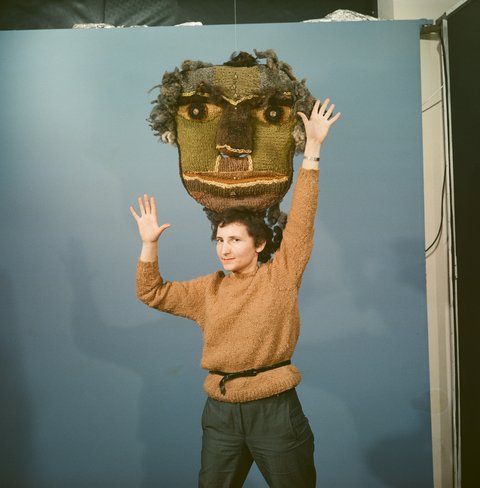
Gabriele Stötzer wears the mask from her "Wool Costume with Mask" (1989) for a photo session at the Wagner Photo Studio
© Christiane Wagner (Fotostudio Wagner), VG Bild-Kunst, Bonn 2025
Interview with Gabriele Stötzer (03. 03. 2025)
Staatliche Kunstsammlungen Dresden, Film: Ramona Stauner / Jacob Franke
Monika Andres
In the works of Monika Andres, fashion objects made of everyday and work materials played a central role. Using different fabrics, colours and symbolic gestures, she created powerful performances and body images. In the interview, she reports how she acquired the materials for her fashion objects and what her relationship with the writing style of the GDR newspapers looked like.
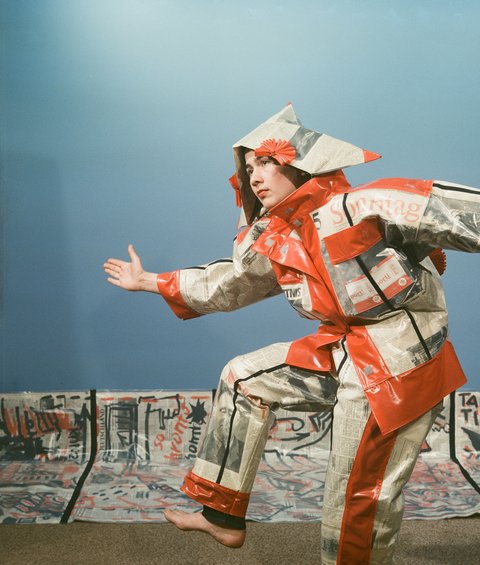
Monika Andres wears her costume "Name, City, Country" (1988) for a photo session at the Wagner Photo Studio 1989
© Monika Andres; Christiane Wagner (Fotostudio Wagner)
Interview with Monika Andres (03. 03. 2025)
Staatliche Kunstsammlungen Dresden, Film: Ramona Stauner / Jacob Franke
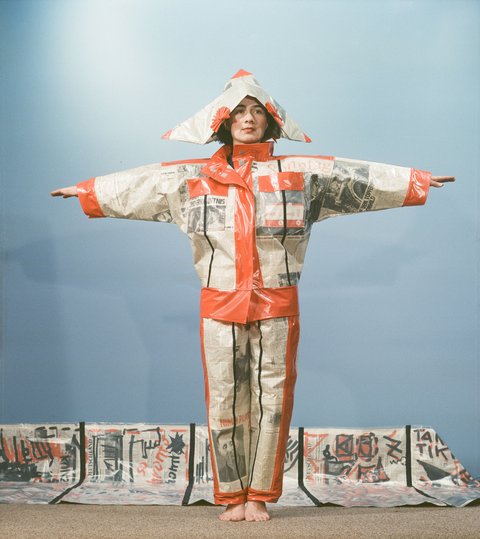
Monika Andres wears her costume "Name, City, Country" (1988) for a photo session at the Wagner Photo Studio 1989
© Christiane Wagner (Fotostudio Wagner); Monika Andres
Verena Kyselka
Verena Kyselka integrated references to media, like TV antennas and musical elements into her performances. She was interested in crossing the borders between art forms and in making societal norms visible. In the interview, she reflects on the creation of the Band EOC – Erweiterter Orgasmus (Eng.: Extended Orgasm) – and her position as an autodidact in the GDR, as well as her studies after the German reunification.
![[Translate to English:] Layout 1 [Translate to English:] Layout 1](/fileadmin/_processed_/3/a/csm_Wagner_Nachrichtensprecherin_tif_4e42817ee0.jpeg)
Verena Kyselka wears her costume "The Newsreader" (1989) for a photo session at the Wagner Photo Studio
© Christiane Wagner (Fotostudio Wagner), VG Bild-Kunst, Bonn 2025
Interview with Verena Kyselka (03. 03. 2025)
Staatliche Kunstsammlungen Dresden, Film: Ramona Stauner / Jacob Franke
Else Gabriel
As co-founder of the Dresden group of auto-perforation artists, together with her fellow students Micha Brendel and Via Lewandowsky, Else Gabriel became one of the most influential voices in performance art in the GDR through radical bodily gestures, material experiments and ironic disruptions. In this interview, Else Gabriel talks about the formation of the group, the boundary-pushing nature of her own art, and the significance of this work from today's perspective.
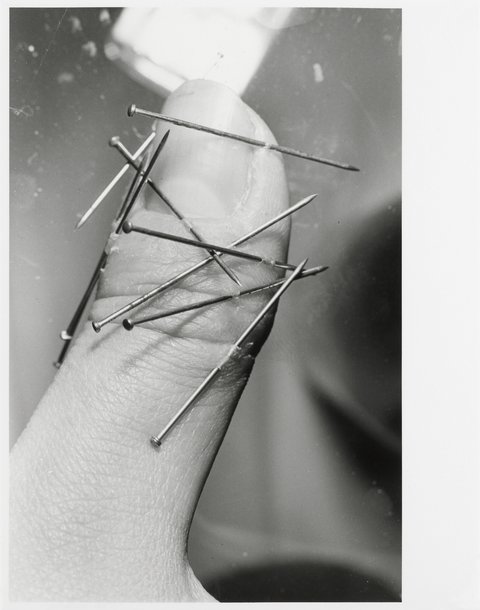
Else Gabriel: The Thumb of Punishment (1986, reprint 1999)
© Staatliche Kunstsammlungen Dresden, Kunstfonds, Foto: Herbert Boswank; VG Bild-Kunst, Bonn 2025
Interview with Else Gabriel (12. 03. 2025)
Staatliche Kunstsammlungen Dresden, Film: Ramona Stauner / Jacob Franke
Hanne Wandtke
The dancer and choreographer Hanne Wandtke was an associate member of the auto-perforation artists and is represented in the exhibition Stepping Out of Line with a rubbish costume. Wandtke designed the costume for the legendary action Spitze des Fleischbergs (Eng.: Top of the Meat Mountain), which took place during the 1986 university carnival at the Dresden Academy of Fine Arts. As a choreographer and through her interest in physical, improvised forms of expression, Wandtke had a significant influence on the work of the auto-perforation artists.
![[Translate to English:] KilligBild [Translate to English:] ddr kunst museum skd](/fileadmin/_processed_/9/4/csm_150525killig018_8f4235019b.jpeg)
Curator Linda Alpermann beside Hanne Wandtke’s "GDR Waste Costume" (1986) in the exhibition "Stepping Out of Line" at the Albertinum 2025
© Staatliche Kunstsammlungen Dresden, Albertinum, Foto: Oliver Killig
Christine Schlegel
In collaboration with dancer Fine Kwiatkowski, Dresden-based painter Christine Schlegel developed performative actions that combined film, painting, dance, and music. Schlegel's works focused on the body and explored tensions between dynamism and stillness. In this interview, she recalls her collaborative practice with Fine, the (limited) artistic freedom in the GDR, and talks about the lasting impact of her art to this day.
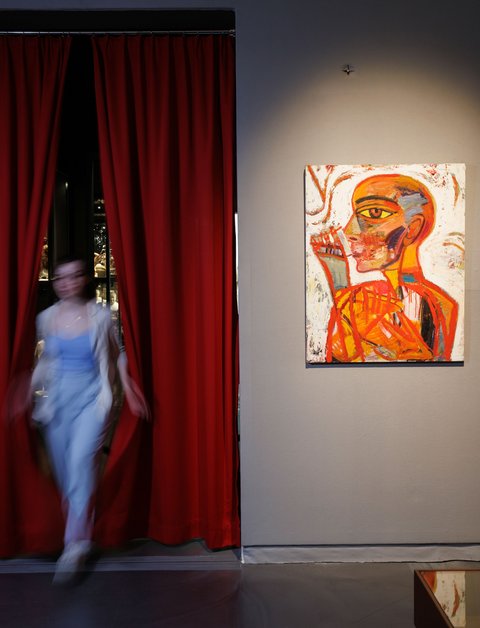
Christine Schlegel: Fine (1984) on display at the exhibition "Stepping Out of Line" at the Albertinum 2025
© Staatliche Kunstsammlungen Dresden, Albertinum, Foto: Oliver Killig; Christine Schlegel
Interview with Christine Schlegel (28. 04. 2025)
Staatliche Kunstsammlungen Dresden, Film: Ramona Stauner / Jacob Franke
Auch interessant:
Der etwa 20-minütige Film „Ein weites Feld. Grüne Rückzugsorte ostdeutscher Künstlerinnen“ von Susanne Altmann entstand 2023 in vier ostdeutschen Gärten und zeigt, wie Systemverweigerung auch aussehen konnte. Vier Künstlerinnen schufen sich jeweils ländliche Refugien, in denen sie inspiriert und unbeobachtet arbeiten konnten und eigene Netzwerke knüpften. Mit Erika Stürmer-Alex, Amrei Bauer für Annemirl Bauer, Christa Jeitner und Christine Schlegel.
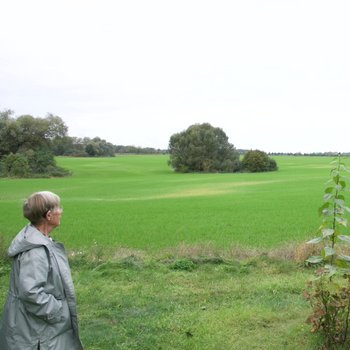
What declares itself to be nonsense declares itself to be harmless. Supposedly. Because the consequence of such self-determination is the famous jester's license, which a group of theater people in the GDR also claimed for themselves in the 1980s when they called themselves “Zinnober” and began making Punch and Judy shows for adults. Their play “Die Jäger des verlorenen Verstandes” (Raiders of the Lost Mind) can easily be read by the audience as a mockery of the GDR state system and its toleration is hard to believe in retrospect - but true.
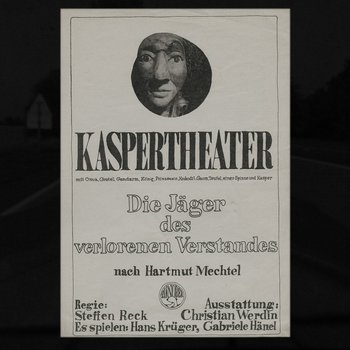
Starting in the 1970s, a type of artistic dialogue developed in East Germany that took place not in museums and galleries but, instead far from the world of public exhibitions, via the postal service. Soon after, the Dresden artist Birger Jesch launched what he called the “first Mail-Art Project of Dresden”, posting 300 cards featuring shooting targets to recipients around the world, for them to design and return.
